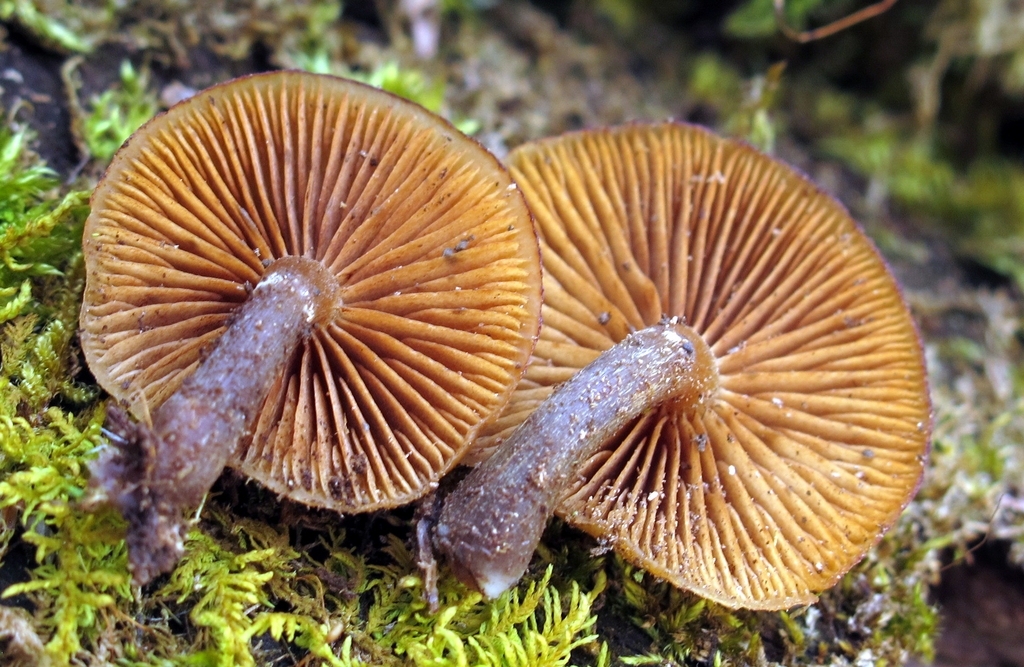Autumn Skullcap Galerina marginata
Other Common Name(s):
Previously known as:
- Galerina autumnalis
- Phonetic Spelling
- gah-ler-EE-nah aw-tum-NAH-lis
- This plant has high severity poison characteristics.
- See below
- Description
-
The small brown sticky caps, white annulus, rusty brown spore prints and occurrence on rotted wood are good diagnostic characteristics of this mushroom. Its cap is small with a diameter of 2/3 to 1.5 inches. This species is one of a complex that is best separated by an expert. G. autumnalis, G. oregonensis, G. unicolor, and G. venenata were once thought of as separate species from Galerina marginata, but are now known to be the same species. Regardless, this is one of North Carolina's most poisonous mushrooms.
This mushroom grows predominantly on decaying conifer wood
Quick ID:
- Cap: Small, about 1.5-2.5 in. in diameter, sticky when moist, dark brown to brownish yellow as it dries, margin striate when wet.
- Gills: Attached to the top of the stalk, yellow becoming brown as spores develop.
- Stalk: Light brown to tan, fibrillose below annulus, hollow, base with dense white mycelium.
- Annulus: White becoming brown with spore deposit, located near the top of the stalk, may disappear with age.
- Spore Print: Rusty brown.
- See this plant in the following landscape:
- Cultivars / Varieties:
-
- Tags:








- Cultivars / Varieties:
-
- Tags:
-
-
Attributes:
- Genus:
- Galerina
- Species:
- marginata
- Family:
- Hymenogastraceae
- Country Or Region Of Origin:
- Europe, North America, and Asia
- Distribution:
- Apparently well distributed throughout NC
- Edibility:
- NOT EDIBLE! See poison information for details.
-
-
Whole Plant Traits:
- Plant Type:
- Mushroom
- Poisonous
- Habit/Form:
- Erect
-
-
Cultural Conditions:
- Light:
- Deep shade (Less than 2 hours to no direct sunlight)
-
-
Fruit:
- Fruit Description:
- No fruit. Develops spores that are rusty brown
-
-
Flowers:
- Flower Description:
- No flowers
-
-
Leaves:
- Hairs Present:
- No
- Leaf Description:
- No leaves
-
-
Stem:
- Stem Color:
- Brown/Copper
- Cream/Tan
- Stem Is Aromatic:
- No
- Stem Description:
- Light brown to tan, fibrillose below annulus, hollow, base with dense white mycelium
-
-
Landscape:
- Problems:
- Poisonous to Humans
-
-
Poisonous to Humans:
- Poison Severity:
- High
- Poison Symptoms:
- Highly toxic, may be fatal if eaten. Symptoms may occur 6-24 hours after eating and include severe abdominal pain, vomiting, and diarrhea which may persist 6-9 hours. Initial symptoms are frequently followed by a lag period up to 24 hours. During this symptomless period, toxins are severely affecting the liver resulting in gastrointestinal bleeding, coma, kidney failure and death usually within 7 days after eating.
- Poison Toxic Principle:
- Amatoxins
- Causes Contact Dermatitis:
- No
- Poison Part:
- Fruits
- Stems






